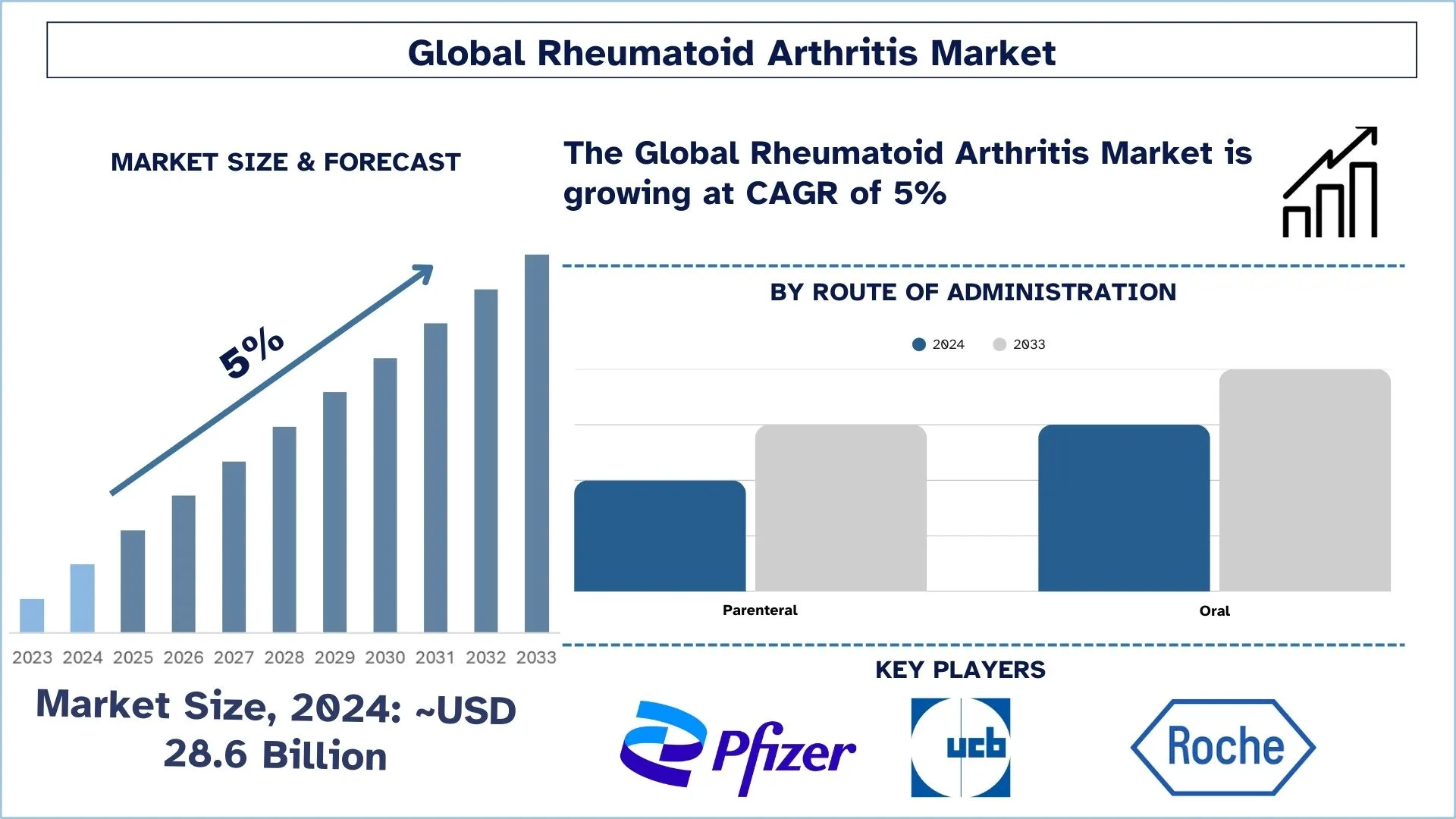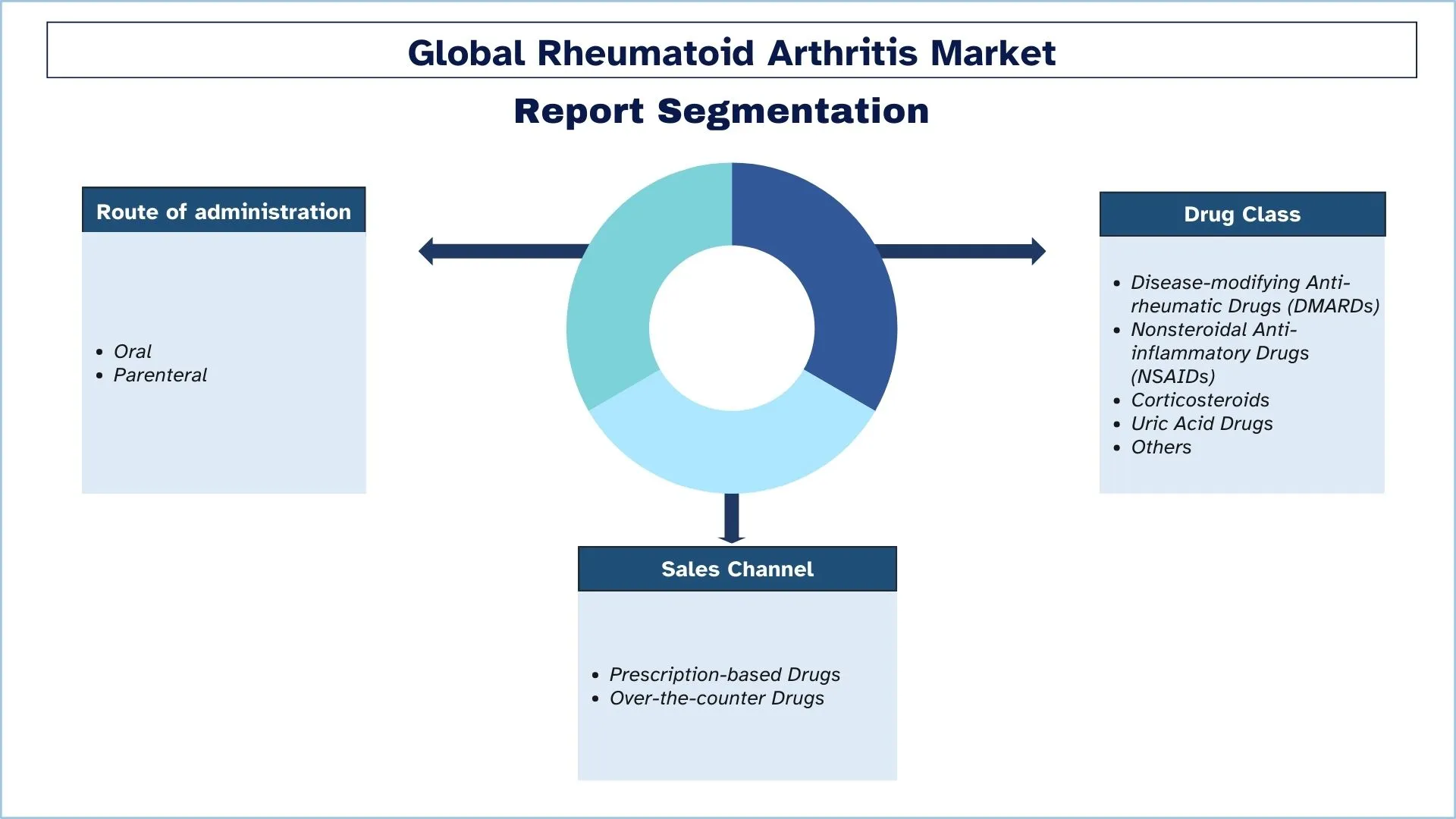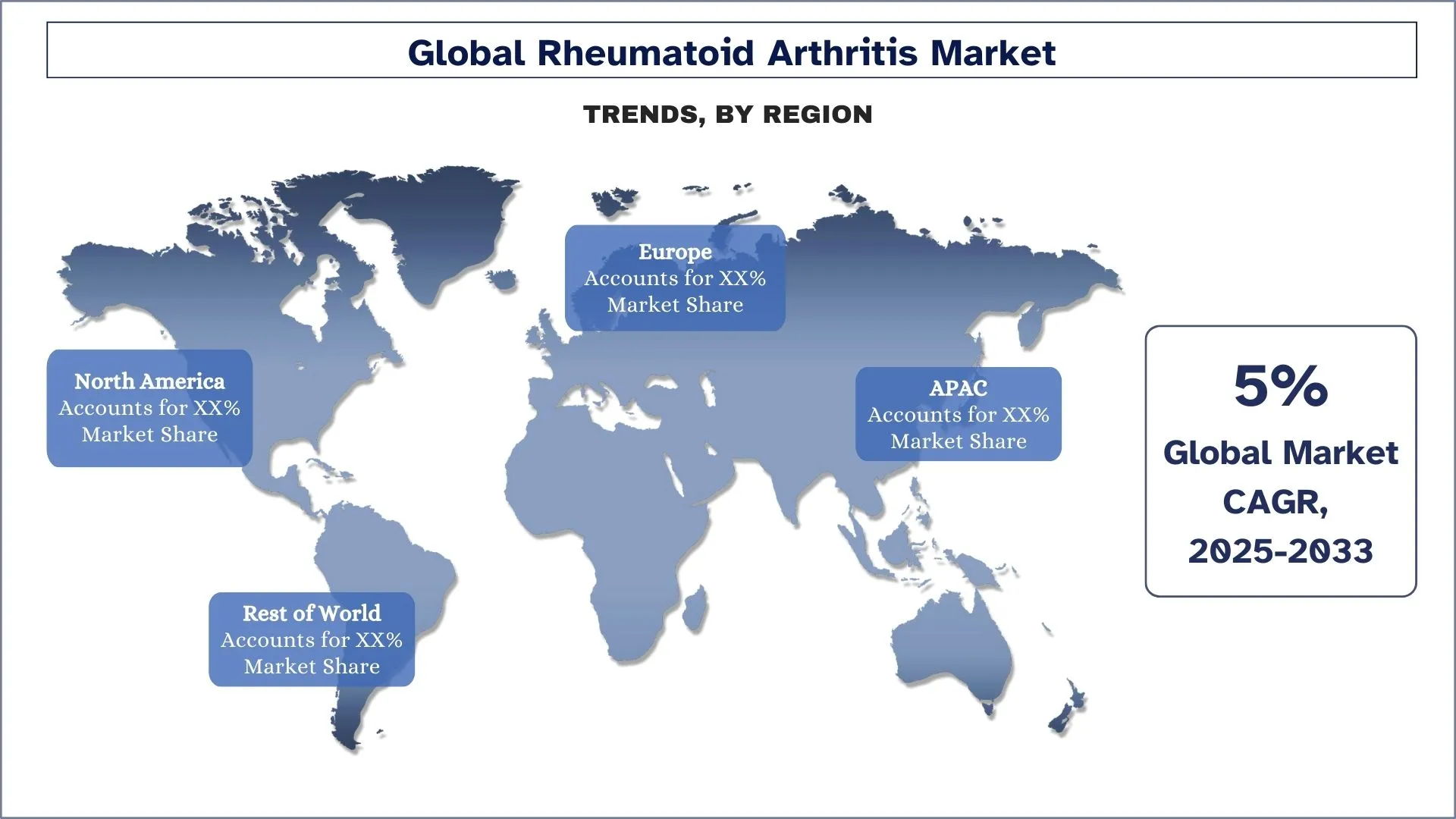- Home
- About Us
- Industry
- Services
- Reading
- Contact Us
Rheumatoid Arthritis Market: Current Analysis and Forecast (2025-2033)
Emphasis on Route of Administration (Oral and Parenteral); Drug Class (Disease-modifying Anti-rheumatic Drugs (DMARDs), Nonsteroidal Anti-inflammatory Drugs (NSAIDs), Corticosteroids, Uric Acid Drugs, and Others), Sales Channel (Prescription-based Drugs and Over-the-counter Drugs); and Region/Country

Rheumatoid Arthritis Market Size & Forecast
The Rheumatoid Arthritis Market was valued at approximately USD 82.6 billion in 2024 and is expected to grow at a substantial CAGR of around 9.5% during the forecast period (2025-2033), owing to the rising cases of RA.
Rheumatoid Arthritis Market Analysis
Rheumatoid arthritis (RA) is a chronic autoimmune disorder that primarily affects the joints, causing inflammation, pain, and potential joint damage. Unlike osteoarthritis, which results from wear and tear, RA occurs when the immune system mistakenly attacks the synovium—the lining of the membranes that surround the joints. This leads to inflammation that can eventually result in bone erosion and joint deformity. Increasing cases of Rheumatoid arthritis are one of the major drivers for the market. For instance, as per the data of census.gov, RA affects about 1% of the global population, with a higher prevalence in women than men. The disease can occur at any age, but it most commonly begins between the ages of 30 and 60.
Rheumatoid Arthritis Market Trends
This section discusses the key market trends influencing the various segments of the Rheumatoid Arthritis Market as identified by our research experts.
Increasing Demand for Biologic and Biosimilar
Biologic drugs have revolutionized RA treatment by targeting specific components of the immune system. These include tumor necrosis factors (TNF) inhibitors, interleukin inhibitors, and B-cell inhibitors. With the patent expiration of many biologics, biosimilar drugs—highly similar, less expensive versions of biologics—are becoming more prevalent, improving accessibility and reducing treatment costs.
Rheumatoid Arthritis Industry Segmentation
This section provides an analysis of the key trends in each segment of the global Rheumatoid Arthritis market report, along with forecasts at the global, regional, and country levels for 2025-2033.
The Oral Segment Holds the Largest Share of the Rheumatoid Arthritis Market.
Based on the route of administration, the market is bifurcated into oral and parenteral. Among these, the oral segment has dominated the market in recent years. Oral medications are generally easier to administer compared to parenteral treatments. Patients can take oral drugs at home without the need for a healthcare professional, which enhances convenience and compliance. This is particularly important for managing chronic conditions like RA, where long-term adherence to treatment is crucial.
The Disease-modifying Anti-Rheumatic Drugs (DMARDs) Market is Expected to Witness a Higher CAGR than the Rheumatoid Arthritis Market.
Based on the Drug Class, the market is segmented into Disease-modifying Anti-rheumatic Drugs (DMARDs), Nonsteroidal Anti-inflammatory Drugs (NSAIDs), Corticosteroids, Uric Acid Drugs, and Others. Disease-modifying antirheumatic drugs (DMARDs) are the primary contributors to revenue in the rheumatoid arthritis treatment market, and their growth is expected to be substantial over the forecast period. This growth is driven by increased awareness of the benefits of DMARDs, a rising prevalence of rheumatoid arthritis, a growing global population of obese and overweight individuals, and the widespread adoption of DMARDs as the first-line treatment for rheumatoid arthritis. These factors collectively enhance the demand for DMARDs, propelling the market forward.

North America has a significant share of the market in 2024.
The Rheumatoid Arthritis market in North America has experienced significant growth in recent years, driven by various factors. North America, particularly the U.S., represents one of the largest markets for Rheumatoid Arthritis globally. One of the primary drivers of the Rheumatoid Arthritis market in North America is the high demand for advanced therapeutics, increasing cases of rheumatoid arthritis, and the rising elderly population. For instance, as of 2022, 16.9% of the U.S. population is aged 65 or older, and this percentage is expected to grow as the Baby Boomer generation ages, according to the data of the Centers for Disease Control and Prevention (CDC). This demographic shift contributes to the rising prevalence of age-related conditions, including RA. Further, North America has a well-established regulatory framework that ensures the safety and efficacy of therapeutics.
U.S. Dominates the North America Rheumatoid Arthritis Market
The US rheumatoid arthritis market is well developed and characterized by keen focus on innovation due to the high level of market development, access to biologics, and targeted drugs. Spire’s disease awareness, early diagnosis rates, and frequent research and development activities by most pharma organizations result in a sound treatment world. Leading companies of AbbVie, Pfizer, Johnson & Johnson, and Eli Lilly in their market have been dominant and influencing the changing trends, in addition to the growing demand for biosimilars and personalized medicine in the market. Also, health care reimbursement and clinical trials by the government enhance the position of the United States as a leading country in the development of RA treatment.

Rheumatoid Arthritis Industry Competitive Landscape
The Rheumatoid Arthritis Market is competitive, with several global and international players. The key players are adopting different growth strategies to enhance their market presence, such as partnerships, agreements, collaborations, new product launches, geographical expansions, and mergers and acquisitions.
Top Rheumatoid Arthritis Companies
Some of the major players operating in the market are UCB S.A.; F. HOFFMANN-LA ROCHE LTD; Pfizer Inc; ABBVIE INC.; Novartis AG; Eli Lilly and Company; Teva Pharmaceuticals, Inc.; BRISTOL-MYERS SQUIBB COMPANY; Merck & Co., Inc.; JOHNSON & JOHNSON
Recent Developments in the Rheumatoid Arthritis Market
In March 2024, Bristol Myers Squibb launched a USD 1.8 million effort to address Socioeconomic Determinants of Health (SDoH) in four countries—Brazil, India, Thailand, and the UK—with underserved patient needs. The new health equity grants extend the company's long-term commitment to invest USD 150 million in health equity by 2025.
In October 2023, Alfasigma S.p.A. agreed to acquire the Jyseleca business from Galapagos, a multinational biotechnology firm headquartered in Belgium specializing in developing revolutionary immunology and oncology treatments.
In July 2023, Boehringer Ingelheim International GmbH received U.S. FDA-approved Cyltezo (adalimumab-adbm), an interchangeable biosimilar to HUMIRA, for treating various chronic inflammatory diseases, including RA in the U.S.
Rheumatoid Arthritis Market Report Coverage
Report Attribute | Details |
Base year | 2024 |
Forecast period | 2025-2033 |
Growth momentum | Accelerate at a CAGR of 9.5% |
Market size 2024 | USD 82.6 Billion |
Regional analysis | North America, Europe, Asia-Pacific, Rest of the World |
Major contributing region | North America is expected to grow to the highest CAGR during the forecasted period. |
Key countries covered | U.S., Canada, Germany, France, UK, Spain, Italy, China, Japan, and India |
Companies profiled | UCB S.A.; F. HOFFMANN-LA ROCHE LTD; Pfizer Inc; ABBVIE INC.; Novartis AG; Eli Lilly and Company; Teva Pharmaceuticals, Inc.; BRISTOL-MYERS SQUIBB COMPANY; Merck & Co., Inc.; JOHNSON & JOHNSON |
Report Scope | Market Trends, Drivers, and Restraints; Revenue Estimation and Forecast; Segmentation Analysis; Demand and Supply Side Analysis; Competitive Landscape; Company Profiling |
Segments Covered | By Route of Administration; By Drug Class, By Sales Channel; By Region/Country |
Reasons to Buy the Rheumatoid Arthritis Market Report:
The study includes market sizing and forecasting analysis validated by authenticated key industry experts.
The report presents a quick review of overall industry performance at a glance.
The report covers an in-depth analysis of prominent industry peers with a primary focus on key business financials, product portfolios, expansion strategies, and recent developments.
Detailed examination of drivers, restraints, key trends, and opportunities prevailing in the industry.
The study comprehensively covers the market across different segments.
Deep dive regional-level analysis of the industry.
Customization Options:
The global Rheumatoid Arthritis market can be customized further as per the requirements or any other market segment. Besides this, UnivDatos understands that you may have your own business needs; hence, feel free to contact us to get a report that completely suits your requirements.
Table of Content
Research Methodology for Rheumatoid Arthritis Market Analysis (2023-2033)
We analyzed the historical market, estimated the current market, and forecasted the future market of the global Rheumatoid Arthritis Market to assess its application in major regions worldwide. We conducted exhaustive secondary research to gather historical market data and estimate the current market size. To validate these insights, we carefully reviewed numerous findings and assumptions. Additionally, we conducted in-depth primary interviews with industry experts across the Rheumatoid Arthritis value chain. After validating market figures through these interviews, we used top-down and bottom-up approaches to forecast the overall market size. We then employed market breakdown and data triangulation methods to estimate and analyze the market size of industry segments and sub-segments.
Market Engineering
We employed data triangulation techniques to finalize the overall market estimation and derive precise statistical numbers for each segment and sub-segment of the global Rheumatoid Arthritis Market. We split the data into several segments and sub-segments by analyzing various parameters and trends, including route of administration, drug class, sales channel, and regions within the global Rheumatoid Arthritis Market.
The main objective of the Global Rheumatoid Arthritis Market Study is to
The study identifies current and future trends in the global Rheumatoid Arthritis Market, providing strategic insights for investors. It highlights regional market attractiveness, enabling industry participants to tap into untapped markets and gain a first-mover advantage. Other quantitative goals of the studies include:
Market Size Analysis: Assess the current and forecast market size of the global Rheumatoid Arthritis Market and its segments in terms of value (USD).
Rheumatoid Arthritis Market Segmentation: The study segments the market by route of administration, drug class, sales channel, and region.
Regulatory Framework & Value Chain Analysis: Examine the regulatory framework, value chain, customer behavior, and competitive landscape of the Rheumatoid Arthritis industry.
Regional Analysis: Conduct a detailed regional analysis for key areas such as Asia Pacific, Europe, North America, and the Rest of the World.
Company Profiles & Growth Strategies: Company profiles of the Rheumatoid Arthritis Market and the growth strategies adopted by the market leaders to sustain the fast-growing market.
Frequently Asked Questions FAQs
Q1: What is the Rheumatoid Arthritis Market's current size and growth potential?
As of 2024, the global Rheumatoid Arthritis market is valued at approximately USD 82.6 billion and is expected to grow at a CAGR of 9.5% through 2033.
Q2: What are the driving factors for the growth of the Rheumatoid Arthritis market?
The global rise in RA cases is propelled by factors such as aging populations, sedentary lifestyles, and genetic predispositions. This growing patient pool is fueling demand for effective treatments and expanding the RA therapeutics market.
Q3: Which market has the largest share of the Rheumatoid Arthritis market by route of administration?
The Oral category currently holds the largest market share in the route of administration segment.
Q4: What are the major trends in the Rheumatoid Arthritis Market?
The expiration of patents for several biologic drugs has opened avenues for biosimilar development. These cost-effective alternatives are gaining traction, especially in emerging markets, making advanced RA treatments more accessible and affordable.
Q5: Which region will dominate the Rheumatoid Arthritis market?
Q6: What are the biggest challenges in the Rheumatoid Arthritis Market?
Despite their efficacy, biologic therapies often come with high price tags, posing affordability issues for many patients. This financial barrier can lead to delayed treatment initiation or non-adherence, adversely affecting patient outcomes.
Q7: Who are the Top players in the global Rheumatoid Arthritis Market?
The leading companies driving innovation in Rheumatoid Arthritis include:
• UCB S.A.
• F. HOFFMANN-LA ROCHE LTD
• Pfizer Inc
• ABBVIE INC.
• Novartis AG
• Eli Lilly and Company
• Teva Pharmaceuticals, Inc.
• BRISTOL-MYERS SQUIBB COMPANY
• Merck & Co., Inc.
• JOHNSON & JOHNSON
Q8: What are the emerging investment opportunities in the global rheumatoid arthritis therapeutics market?
• The market is evolving with opportunities in biosimilars, oral JAK inhibitors, and targeted synthetic DMARDs, which offer improved efficacy and patient compliance.
• Investors are increasingly focusing on R&D partnerships, pipeline assets with differentiated mechanisms, and digital health solutions for RA monitoring and management.
• Expansion into emerging markets with high unmet medical needs also presents significant growth potential.
Q9: How can pharmaceutical companies maintain a competitive edge in the rheumatoid arthritis drug market?
• Companies can stay competitive by innovating beyond TNF inhibitors, investing in biomarker research for personalized treatment, and accelerating regulatory approvals globally.
• Strengthening real-world evidence (RWE) generation, enhancing patient access programs, and adopting strategic pricing models are key to long-term success.
• Leveraging digital engagement platforms and telehealth can also improve patient adherence and outcomes, fostering brand loyalty.
Related Reports
Customers who bought this item also bought










